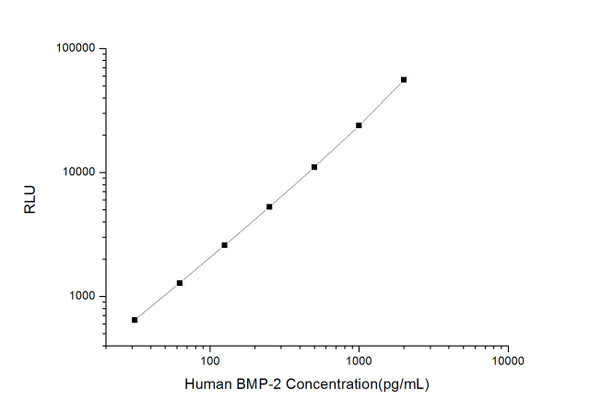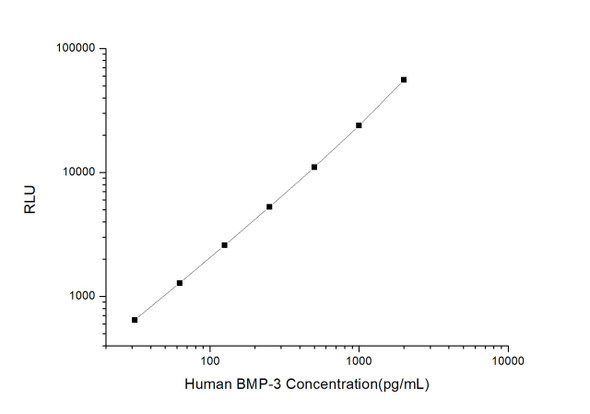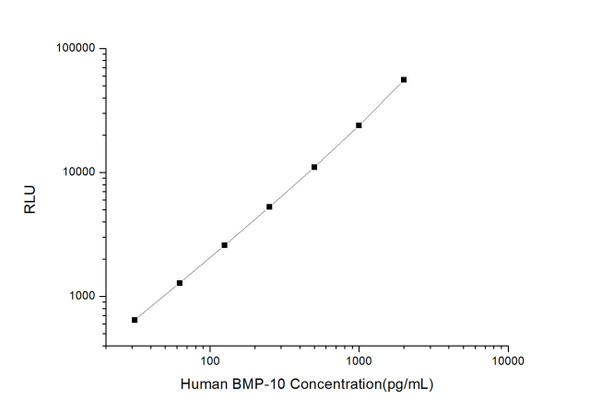Human Cell Biology ELISA Kits 3
Human BMP-15 (Bone Morphogenetic Protein 15) CLIA Kit (HUES00395)
- SKU:
- HUES00395
- Product Type:
- ELISA Kit
- ELISA Type:
- CLIA Kit
- Size:
- 96 Assays
- Sensitivity:
- 18.75pg/mL
- Range:
- 31.25-2000pg/mL
- ELISA Type:
- Sandwich
- Synonyms:
- BMP15, GDF9B, ODG2, POF4
- Reactivity:
- Human
- Sample Type:
- Serum, plasma and other biological fluids
- Research Area:
- Cell Biology
Description
| Assay type: | Sandwich |
| Format: | 96T |
| Assay time: | 4.5h |
| Reactivity: | Human |
| Detection method: | Chemiluminescence |
| Detection range: | 31.25-2000 pg/mL |
| Sensitivity: | 18.75 pg/mL |
| Sample volume: | 100µL |
| Sample type: | Serum, plasma and other biological fluids |
| Repeatability: | CV < 15% |
| Specificity: | This kit recognizes Human BMP-15 in samples. No significant cross-reactivity or interference between Human BMP-15 and analogues was observed. |
This kit uses Sandwich-CLIA as the method. The micro CLIA plate provided in this kit has been pre-coated with an antibody specific to Human BMP-15. Standards or samples are added to the appropriate micro CLIA plate wells and combined with the specific antibody. Then a biotinylated detection antibody specific for Human BMP-15 and Avidin-Horseradish Peroxidase (HRP) conjugate are added to each micro plate well successively and incubated. Free components are washed away. The substrate solution is added to each well. Only those wells that contain Human BMP-15, biotinylated detection antibody and Avidin-HRP conjugate will appear fluorescence. The Relative light unit (RLU) value is measured spectrophotometrically by the Chemiluminescence immunoassay analyzer. The RLU value is positively associated with the concentration of Human BMP-15. The concentration of Human BMP-15 in the samples can be calculated by comparing the RLU of the samples to the standard curve.
| UniProt Protein Function: | BMP15: May be involved in follicular development. Oocyte- specific growth/differentiation factor that stimulates folliculogenesis and granulosa cell (GC) growth. Defects in BMP15 are the cause of ovarian dysgenesis type 2 (ODG2); also known as X-linked hypergonadotropic ovarian dysgenesis or hypergonadotropic ovarian failure due to ovarian dysgenesis. Ovarian dysgenesis leads to ovarian failure and accounts for about half of the cases of primary amenorrhea. Defects in BMP15 are the cause of premature ovarian failure type 4 (POF4). An ovarian disorder defined as the cessation of ovarian function under the age of 40 years. It is characterized by oligomenorrhea or amenorrhea, in the presence of elevated levels of serum gonadotropins and low estradiol. Belongs to the TGF-beta family. |
| UniProt Protein Details: | Protein type:Secreted, signal peptide; Secreted; Cytokine Chromosomal Location of Human Ortholog: Xp11. 2 Cellular Component: extracellular space; cytoplasm Molecular Function:growth factor activity; cytokine activity; transforming growth factor beta receptor binding Biological Process: BMP signaling pathway; regulation of apoptosis; granulosa cell development; ovarian follicle development; positive regulation of transcription, DNA-dependent; regulation of MAPKKK cascade; female gamete generation; cell development Disease: Ovarian Dysgenesis 2 |
| NCBI Summary: | This gene encodes a secreted ligand of the TGF-beta (transforming growth factor-beta) superfamily of proteins. Ligands of this family bind various TGF-beta receptors leading to recruitment and activation of SMAD family transcription factors that regulate gene expression. The encoded preproprotein is proteolytically processed to generate subunits of a disulfide-linked homodimer, or alternatively, a heterodimer, with the related protein, growth differentiation factor 9 (GDF9). This protein plays a role in oocyte maturation and follicular development, through activation of granulosa cells. Defects in this gene are the cause of ovarian dysgenesis and are associated with premature ovarian failure. [provided by RefSeq, Aug 2016] |
| UniProt Code: | O95972 |
| NCBI GenInfo Identifier: | 51338749 |
| NCBI Gene ID: | 9210 |
| NCBI Accession: | O95972. 2 |
| UniProt Related Accession: | O95972 |
| Molecular Weight: | |
| NCBI Full Name: | Bone morphogenetic protein 15 |
| NCBI Synonym Full Names: | bone morphogenetic protein 15 |
| NCBI Official Symbol: | BMP15 |
| NCBI Official Synonym Symbols: | ODG2; POF4; GDF9B |
| NCBI Protein Information: | bone morphogenetic protein 15 |
| UniProt Protein Name: | Bone morphogenetic protein 15 |
| UniProt Synonym Protein Names: | Growth/differentiation factor 9B |
| Protein Family: | Bone morphogenetic protein |
| UniProt Gene Name: | BMP15 |
| UniProt Entry Name: | BMP15_HUMAN |
As the RLU values of the standard curve may vary according to the conditions of the actual assay performance (e. g. operator, pipetting technique, washing technique or temperature effects), the operator should establish a standard curve for each test. Typical standard curve and data is provided below for reference only.
| Concentration (pg/mL) | RLU | Average | Corrected |
| 2000 | 55476 55966 | 55721 | 55693 |
| 1000 | 22917 25031 | 23974 | 23946 |
| 500 | 11417 10647 | 11032 | 11004 |
| 250 | 4835 5753 | 5294 | 5266 |
| 125 | 2652 2564 | 2608 | 2580 |
| 62.5 | 1404 1218 | 1311 | 1283 |
| 31.25 | 658 690 | 674 | 646 |
| 0 | 27 29 | 28 | -- |
Precision
Intra-assay Precision (Precision within an assay): 3 samples with low, mid range and high level Human BMP-15 were tested 20 times on one plate, respectively.
Inter-assay Precision (Precision between assays): 3 samples with low, mid range and high level Human BMP-15 were tested on 3 different plates, 20 replicates in each plate.
| Intra-assay Precision | Inter-assay Precision | |||||
| Sample | 1 | 2 | 3 | 1 | 2 | 3 |
| n | 20 | 20 | 20 | 20 | 20 | 20 |
| Mean (pg/mL) | 93.07 | 182.83 | 789.88 | 100.01 | 184.42 | 743.52 |
| Standard deviation | 10.64 | 19.65 | 58.77 | 8.50 | 21.80 | 50.56 |
| C V (%) | 11.43 | 10.75 | 7.44 | 8.50 | 11.82 | 6.80 |
Recovery
The recovery of Human BMP-15 spiked at three different levels in samples throughout the range of the assay was evaluated in various matrices.
| Sample Type | Range (%) | Average Recovery (%) |
| Serum (n=5) | 90-104 | 97 |
| EDTA plasma (n=5) | 84-95 | 90 |
| Cell culture media (n=5) | 97-109 | 102 |
Linearity
Samples were spiked with high concentrations of Human BMP-15 and diluted with Reference Standard & Sample Diluent to produce samples with values within the range of the assay.
| Serum (n=5) | EDTA plasma (n=5) | Cell culture media (n=5) | ||
| 1:2 | Range (%) | 84-99 | 90-103 | 97-111 |
| Average (%) | 90 | 95 | 103 | |
| 1:4 | Range (%) | 85-101 | 103-120 | 88-103 |
| Average (%) | 92 | 109 | 94 | |
| 1:8 | Range (%) | 99-111 | 84-96 | 99-111 |
| Average (%) | 105 | 91 | 105 | |
| 1:16 | Range (%) | 93-105 | 97-111 | 91-105 |
| Average (%) | 98 | 104 | 97 |
An unopened kit can be stored at 4°C for 1 month. If the kit is not used within 1 month, store the items separately according to the following conditions once the kit is received.
| Item | Specifications | Storage |
| Micro CLIA Plate(Dismountable) | 8 wells ×12 strips | -20°C, 6 months |
| Reference Standard | 2 vials | |
| Concentrated Biotinylated Detection Ab (100×) | 1 vial, 120 µL | |
| Concentrated HRP Conjugate (100×) | 1 vial, 120 µL | -20°C(shading light), 6 months |
| Reference Standard & Sample Diluent | 1 vial, 20 mL | 4°C, 6 months |
| Biotinylated Detection Ab Diluent | 1 vial, 14 mL | |
| HRP Conjugate Diluent | 1 vial, 14 mL | |
| Concentrated Wash Buffer (25×) | 1 vial, 30 mL | |
| Substrate Reagent A | 1 vial, 5 mL | 4°C (shading light) |
| Substrate Reagent B | 1 vial, 5 mL | 4°C (shading light) |
| Plate Sealer | 5 pieces | |
| Product Description | 1 copy | |
| Certificate of Analysis | 1 copy |
- Set standard, test sample and control (zero) wells on the pre-coated plate and record theirpositions. It is recommended to measure each standard and sample in duplicate. Note: addall solutions to the bottom of the plate wells while avoiding contact with the well walls. Ensuresolutions do not foam when adding to the wells.
- Aliquot 100µl of standard solutions into the standard wells.
- Add 100µl of Sample / Standard dilution buffer into the control (zero) well.
- Add 100µl of properly diluted sample (serum, plasma, tissue homogenates and otherbiological fluids. ) into test sample wells.
- Cover the plate with the sealer provided in the kit and incubate for 90 min at 37°C.
- Aspirate the liquid from each well, do not wash. Immediately add 100µL of BiotinylatedDetection Ab working solution to each well. Cover the plate with a plate seal and gently mix. Incubate for 1 hour at 37°C.
- Aspirate or decant the solution from the plate and add 350µL of wash buffer to each welland incubate for 1-2 minutes at room temperature. Aspirate the solution from each well andclap the plate on absorbent filter paper to dry. Repeat this process 3 times. Note: a microplatewasher can be used in this step and other wash steps.
- Add 100µL of HRP Conjugate working solution to each well. Cover with a plate seal andincubate for 30 min at 37°C.
- Aspirate or decant the solution from each well. Repeat the wash process for five times asconducted in step 7.
- Add 100µL of Substrate mixture solution to each well. Cover with a new plate seal andincubate for no more than 5 min at 37°C. Protect the plate from light.
- Determine the RLU value of each well immediately.






